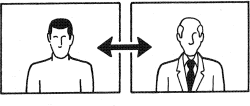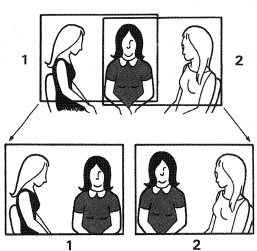Intercut Shots
There are occasions when one presents the audience with a shot, and invites them to look around it, choosing their own centres of interest. But more often, we want them to look at certain aspects of the scene. We want to persuade them to concentrate on particular features of the subjects to watch the chemical process, not the person operating the equipment.
Guiding the audience
During most productions, the director is continually guiding the viewer’s attention … taking their interest from one aspect of the scene to another… showing different features of the subject … introducing the viewer to new subjects.
The most obvious way of redirecting their concentration is to reframe the shot, or zoom in, or move the camera around to another viewpoint. But these methods don’t allow us to make instantaneous changes. To do that, we need to intercut between shots. When a cut is made skillfully, the audience will accept it as‘naturally’ as a blink, or a rapid repositioning of the eyes. Badly done, it becomes a visual jolt, that draws our attention to the transition.
Typical treatment
When people talk together (interviews, discussions), we usually cross-cut between them, to watch their delivery and reactions. The idea seems straightforward enough. But as you will see on the opposite page, some strange effects can develop that cause a momentary visual shock.
Above all, never cut between nearly identical shots of the same subject Try it and see why! it is surprising how often, when left to find their own shots, a camera crew will unknowingly present a series of similar pictures. Switching between them achieves nothing but visual jumps.
You’ll get a similar effect if you take a continuous shot of someone talking, then decide to omit sequences. Each editing cut causes a disturbing jump cut as the picture changes. Some directors ignore the disruption, or introduce a quick mix to disguise it. Even a rapid ‘fadeout to black, then fade in’ (dip) has been tried. But the best solution is to insert a cutaway or a reaction shot (‘nod shot’).
Shooting people
When shooting people, reverse angle shots intercutting frontal and rear viewpoints (‘over-shoulder shots’) are an effective way of showing their relative positions. But take care that you do not cause them to jump from side to side of the frame! That can happen if cameras are shooting from opposite sides of an imaginary line joining these subjects — crossing the line (page 39). Some directors ignore such niceties, and just leave the viewer to work out what is happening!
Transformations
When we cut between identical shots of different subjects, transformations take place.

Size jumps
‘Shrinkage’ or ‘growth’ occurs on cutting to a different shot size of the subject from a similar angle.

Position twists
Cutting to a similar shot of the sybject, from a different angle, can create a visyal ‘twist’.

Frame jump (Jump cut)
Here the frame position of the sybiect changes on the cut.

